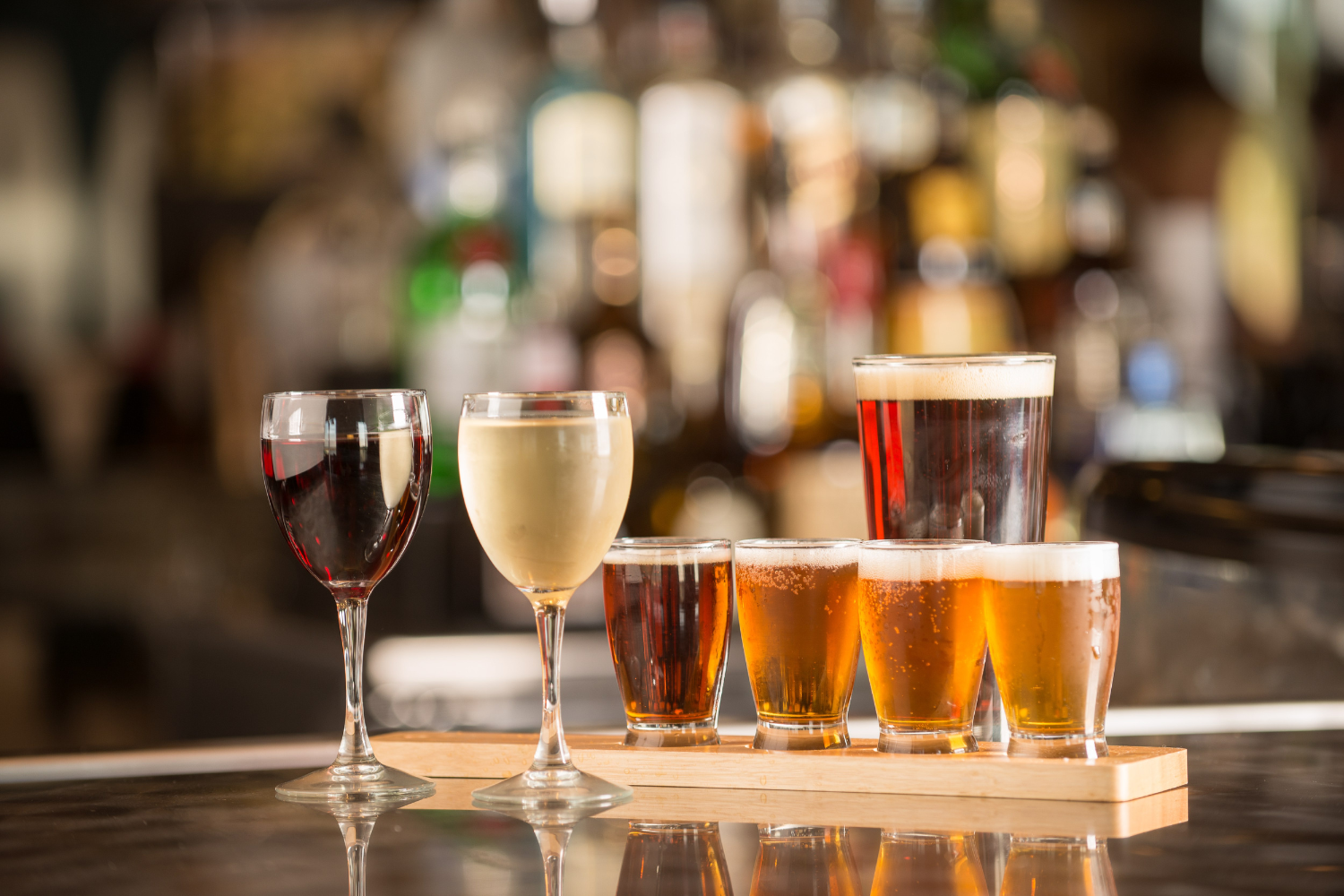Not all alcoholic beverages affect the liver the same way, and understanding which ones cause the most harm can make a big difference for liver health. Some drinks contain ingredients or alcohol levels that are associated with greater strain on the liver, which over time may contribute to factors linked with reduced liver function, especially with excessive alcohol consumption.
Factors like too much sugar, high fructose corn syrup, and alcohol content can put extra strain on this vital organ, increasing the risk of scarring, inflammation, and liver failure. This guide looks at the worst alcohol for liver metabolism, why certain types, such as hard liquor, beer, and sweet mixed drinks, can be more harmful, and how drinking habits, diet, and overall health influence your risk.
Why Some Alcohols Place More Demand on Liver Function
Different types of alcoholic beverages place varying levels of stress on the liver, and these differences often come down to how the body processes alcohol, sugar, and other additives. The liver works to filter toxins, but high alcohol content, too much sugar, and harmful additives can increase the metabolic load, leading to greater health risks over time.
Alcohol concentration and metabolic load
Hard liquor has a higher alcohol concentration than beer or wine, which means the liver cells must work harder to break it down. The more concentrated the alcohol, the faster blood alcohol levels rise, forcing this vital organ to process more toxins in less time. Over time, repeated exposure to high concentrations may contribute to factors associated with liver inflammation and reduced liver resilience.
How sugars and additives affect alcohol metabolism
Alcoholic beverages with added sugars or high fructose corn syrup, such as flavored malt beverages or pre-mixed cocktails, create a double burden for the liver. The organ must metabolize both the alcohol and the sugar, which can contribute to fat accumulation in the liver, a factor often associated with reduced liver function. This extra strain can contribute to obesity, diabetes, and other forms of liver disease.
Why quantity and frequency matter more than brand or type
While certain drinks can be more harmful, drinking habits often make the biggest difference. Regular excessive alcohol consumption, even with lower-strength beverages, increases the likelihood of liver damage, alcoholic hepatitis, and cirrhosis. Spacing out drinks, limiting intake, and allowing the liver time to recover can help reduce the long-term risk.

How Beer and Wine Compare to Spirits in Liver Metabolism
Beer, wine, and spirits all affect the liver differently because of their alcohol content, serving size, and added ingredients. Understanding these differences helps you make more informed choices about your health.
Beer vs spirits: content and volume tradeoffs
Beer has less alcohol by volume than spirits, but it’s often consumed in larger amounts, which can still place significant strain on the liver. Spirits like vodka or whiskey have higher alcohol content, meaning fewer drinks can quickly raise blood alcohol levels.
|
Beer |
4–6% ABV |
12 oz (355 ml) |
Larger volumes add calories, carbs, and may contribute to weight gain and changes in liver fat content. |
|
Spirits |
35–50% ABV |
1.5 oz (44 ml) |
Higher concentration increases metabolic load and risk of liver inflammation. |
Wine and polyphenols: science vs speculation
Some research points to polyphenols in wine, which may have potential antioxidant effects, but the alcohol still poses clear risks. Even moderate wine consumption has been linked in some research to markers associated with reduced liver health, especially in people with certain health or genetic risk factors.
What to know about additives and fermentable sugars
Certain beers and wines contain fermentable sugars and additives that can worsen liver health. Sugary cocktails, sweet wines, and flavored beers often contain too much sugar, which may contribute to fat accumulation and changes in liver tissue structure over time.

Are Beer or Wine Any Better?
Some people believe beer or wine is less harmful than hard liquor, but the difference often lies in how much and how often you drink rather than the type itself.
The debate: Beer vs hard liquor
Beer’s lower alcohol content may seem safer, but larger servings can still deliver significant alcohol and calories. Hard liquor is more concentrated, so smaller amounts can still cause harmful effects on liver cells.
|
Beer |
4–6% ABV |
Often consumed in multiple servings |
Can lead to fat buildup, inflammation, and overweight-related liver risks. |
|
Hard Liquor |
35–50% ABV |
Smaller serving size, higher potency |
Greater metabolic strain in shorter time, increasing liver damage risk. |
Is wine less damaging, or just differently risky?
Wine is often perceived as healthier due to antioxidants like polyphenols, but the alcohol content still carries the same dangers. Women, people with obesity, and those with a family history of liver disease may face higher risks even with moderate wine intake.
How additives in beer or wine can also impact your liver
Additives, preservatives, and flavorings in some beers and wines can add to the liver’s workload. These substances, along with alcohol, can contribute to inflammation, scarring, and long-term harm to this vital organ.
Drinking Patterns That Increase the Liver’s Metabolic Workload
How you drink can place as much stress on the liver as what you drink. Certain habits speed up alcohol absorption, increase blood alcohol levels, and force the liver to work harder to process toxins and sugars.
Binge vs moderate intake: volume and frequency matter
Binge drinking floods the body with alcohol in a short time, overwhelming liver cells and increasing the risk of inflammation, fatty liver disease, and alcoholic hepatitis. Moderate intake allows more time for metabolism, reducing the chance of immediate harm but still carrying risks if it becomes a regular habit.
|
Binge Drinking |
4+ drinks for women, 5+ for men in 2 hours |
Overloads liver function, raises toxin build up, increases risk of scarring |
May be associated with factors that affect liver structure and function |
|
Moderate Drinking |
Up to 1 drink/day for women, 2 for men |
Less immediate harm, but cumulative effects possible |
May contribute to metabolic changes linked with weight gain and reduced liver efficiency |
Why drinking without food increases metabolic impact
Alcohol enters the bloodstream faster on an empty stomach, which spikes blood alcohol levels and increases the strain on the liver. Eating nutrient-rich food—especially protein and fresh fruits—before drinking can slow absorption and reduce harm.
Alcohol with medications or stimulants: what to ask your doctor
Mixing alcohol with certain medications or stimulants may increase the risk of harmful effects on the liver and other organs. Some combinations increase toxicity or slow alcohol metabolism, leading to more damage over time.
What to ask your doctor:
-
Can this medication cause liver damage when combined with alcohol?
-
How does alcohol affect the way my body processes this drug?
-
Should I avoid alcohol completely while taking this medication?
-
Are there safer alternatives that reduce liver strain?

How to Support Liver Function While Drinking
If you choose to drink, certain strategies can help reduce liver stress and support overall health, though no method fully removes the risks.
Choosing lower-alcohol, additive-free options
Opting for lower-alcohol beverages without harmful additives, high fructose corn syrup, or too much sugar can ease the liver’s metabolic workload. Reading labels and avoiding flavored alcoholic drinks with unnecessary ingredients can make a big difference.
The role of hydration and food in alcohol metabolism
Drinking water alongside alcohol helps the body process toxins and maintain hydration. Pairing alcohol with nutrient-rich meals provides the liver with essential nutrients to better handle the metabolic load.
When to consider a break based on lifestyle or health goals
If you are trying to lose weight, improve liver health, or manage conditions like diabetes or fatty liver, taking a break from alcohol may support healthy inflammatory balance and normal fat metabolism in the liver. Even short-term breaks allow the liver time to recover.
When to Reevaluate Alcohol Intake Based on Health Considerations
Certain health markers, lifestyle changes, or risk factors may signal it’s time to adjust drinking habits for better public health outcomes and personal well-being.
Discussing alcohol intake with a doctor if managing liver markers
Abnormal liver enzyme results, symptoms like fatigue, or early signs of liver disease should prompt a conversation with your doctor. They can recommend treatment options, lifestyle changes, or further testing to help manage lifestyle factors that support long-term liver health.
Why genetic and metabolic factors matter
A family history of liver disease, obesity, or diabetes can increase the likelihood of alcohol-related harm. These genetic and metabolic factors can make even moderate drinking dangerous, leading to earlier onset of scarring and cirrhosis.
Alcohol and medication interactions: key questions to ask
Some prescriptions, over-the-counter drugs, and herbal supplements interact poorly with alcohol, leading to dangerous effects on the liver, blood, and other vital organs.
Questions to ask:
-
Does this medication interact with alcohol in a harmful way?
-
Will alcohol slow or change how my body processes this drug?
-
Could combining them increase my risk of liver damage or other health problems?
-
Are there safer treatment forms that allow occasional drinking?
The Worst Alcohol for Your Liver Might Not Be What You Think
Protecting liver health isn’t just about avoiding the worst alcohol for liver function—it’s about recognizing that how much you drink, how often, and the added sugars or harmful ingredients matter just as much as the type of beverage. High-strength hard liquor, sweet mixed drinks, and beverages with high fructose corn syrup or excess sugar may contribute to factors associated with reduced liver health.
Smarter habits, hydration, and mindful choices can reduce harm, and for those looking for added nutritional support, Drinkwel offers supplements designed to help maintain overall health while supporting the body’s natural liver function.
Frequently Asked Questions
Which alcohol types are most demanding for liver metabolism?
High-proof hard liquor and sweetened alcoholic beverages place the greatest metabolic load on the liver.
Is vodka worse for the liver than beer or wine?
Vodka’s higher alcohol concentration can strain the liver more quickly, but excessive beer or wine intake can be equally harmful over time.
What types of alcohol have higher alcohol or sugar content?
Spirits, dessert wines, and sweet cocktails often have the highest alcohol or sugar levels.
Is it safer to drink low-alcohol drinks for your liver?
Lower-alcohol drinks may reduce strain, but regular intake can still lead to liver damage.
How does liver function respond to changes in alcohol intake?
Reducing or stopping alcohol may support liver health and, in some cases, help improve certain liver function measures, depending on the stage of liver disease and individual health factors.
References
-
Chiva-Blanch, G., & Badimon, L. (2017). Effects of Polyphenol Intake on Metabolic Syndrome: Current Evidences from Human Trials. Oxidative medicine and cellular longevity, 2017, 5812401. https://doi.org/10.1155/2017/5812401
-
Courtney, K. E., & Polich, J. (2009). Binge drinking in young adults: Data, definitions, and determinants. Psychological bulletin, 135(1), 142–156. https://doi.org/10.1037/a0014414
-
Ramchandani, V. A., Bosron, W. F., & Li, T. K. (2001). Research advances in ethanol metabolism. Pathologie-biologie, 49(9), 676–682. https://doi.org/10.1016/s0369-8114(01)00232-2
-
Stickel, F., & Hampe, J. (2012). Genetic determinants of alcoholic liver disease. Gut, 61(1), 150–159. https://doi.org/10.1136/gutjnl-2011-301239
-
Wiese, J. G., Shlipak, M. G., & Browner, W. S. (2000). The alcohol hangover. Annals of internal medicine, 132(11), 897–902. https://doi.org/10.7326/0003-4819-132-11-200006060-00008
-
Zakhari, S., & Li, T. K. (2007). Determinants of alcohol use and abuse: Impact of quantity and frequency patterns on liver disease. Hepatology (Baltimore, Md.), 46(6), 2032–2039. https://doi.org/10.1002/hep.22010
